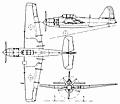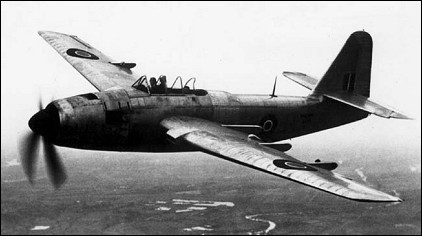|
| The first prototype flew on July 5, 1945.
 | A three-view drawing (676 x 584) |
| CREW | 2 |
| ENGINE | 1 x 2585hp Bristol Centaurus 57 |
| WEIGHTS |
| Take-off weight | 10026 kg | 22104 lb |
| Empty weight | 6901 kg | 15214 lb |
| DIMENSIONS |
| Wingspan | 18.36 m | 60 ft 3 in |
| Length | 13.59 m | 45 ft 7 in |
| Height | 4.11 m | 14 ft 6 in |
| Wing area | 49.24 m2 | 530.01 sq ft |
| PERFORMANCE |
| Max. speed | 470 km/h | 292 mph |
| Ceiling | 7620 m | 25000 ft |
| Range | 1674 km | 1040 miles |
| ARMAMENT | 2-4 x 12.7mm machine guns, 4 x 227kg bombs |
| Anonymous, 04.11.2021 21:22 The Fleet Air Arm's answer to the Grumman Avenger, only too big, too slow, too unwieldy and too late. reply | | Barry, 18.11.2015 19:10 Ordered by the Royal Navy to serve on their proposed 45,000 ton Malta class aircraft carriers, the Spearfish was half again as large as the Barracuda the plane it was to replace. The war ended and the Malta class carriers were cancelled along with the Spearfish. Five of which had been built but only 4 of which flew. reply | | Terrence I. Murphy, e-mail, 10.02.2012 01:49 Except for the high cockpit, it looked fast, but went slow. reply | | John Dighton, e-mail, 25.02.2010 12:28 Much like the other Fairey aircraft of WWII, solid airframes, but underpowered and underperformed. reply |
|
Do you have any comments?
|
| 
COMPANY
PROFILE
All the World's Rotorcraft
|











